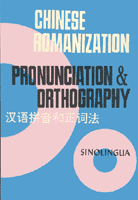 Today’s selection from Yin Binyong’s Chinese Romanization: Pronunciation and Orthography is onomatopoeic words (340 KB PDF).
Today’s selection from Yin Binyong’s Chinese Romanization: Pronunciation and Orthography is onomatopoeic words (340 KB PDF).
Yin Binyong makes a distinction between onomatopoeic words that originate in Literary Sinitic (which thus generally have fixed forms in Chinese characters) and those from Modern Mandarin. The former can be written with tone marks, the latter aren’t.
In practice that distinction may well be more trouble than it’s worth. But I was happy to learn a new expression from his examples: shūshēnglǎnglǎng (the sound of reading aloud), which YBY writes as two words and the ABC Chinese-English Comprehensive Dictionary writes solid.
OK, for some niceties and examples:
Some of these words can be stretched out for auditory effect; to express this lengthening in writing, a dash is added after the syllable:
- Du — , qìdi xiǎng le. (Toot went the steam whistle.)
- Dà gōngjī, o — o — tí. (The rooster crowed cock-a-doodle-do.)
Reduplication is of course quite common in Mandarin.
- huahua (sound of water or rain)
- huhu (sound of wind)
- wawa (sound of calling or crying)
- dongdong (sound of beating drums).
- wangwang (sound of a dog barking)
- miaomiao (sound of a cat meowing)
- jiji (sound of insects buzzing or chirping)
- zizi (sound of a mouse squeaking)
- gugu (sound of a pigeon cooing)
- wengweng (sound of bees or flies buzzing)
- gaga (sound of a duck quacking)
- haha (sound of laughter)
- heihei (sound of bitter or sardonic laughter)
- xixi (sound of giggling)
- gege (sound of guffawing)
All of those could also be written tripled instead of doubled, e.g., wangwangwang, miaomiaomiao, hahaha.
Yin provides some orthographic rules based on the patterns of the onomatopoeic words. The sound of a ticking clock, for example, could take various forms, such as
- dida
- dida dida
- didi-dada
Note spacing, hyphens, and lack thereof. See the PDF for all the details.
Still, don’t sweat the stylistic niceties of these too much. It’s onomatopoeia, so have fun!
further reading:
- Japanese (and Chinese) Onomatopoeia, Victor Mair at Language Log, July 2008
- Zrrr, Zrrr! What does your police car say?, Beijing Sounds, April 2008 — and lots of other posts there
- Some Things Chinese Characters Can’t Do-Be-Do-Be-Do

![Yes, I know that's not a word-for-word translation, but it's what they use in the official version (I think). image from 'Crouching Tiger, Hidden Dragon' with the lines Pei? Hànrén méiyǒu zhèzhǒng míngzi de. [Pei? I didn't think the Hans had names like that.]](https://pinyin.info/news/news_photos/2009/04/crouching_tiger_pei.jpg)